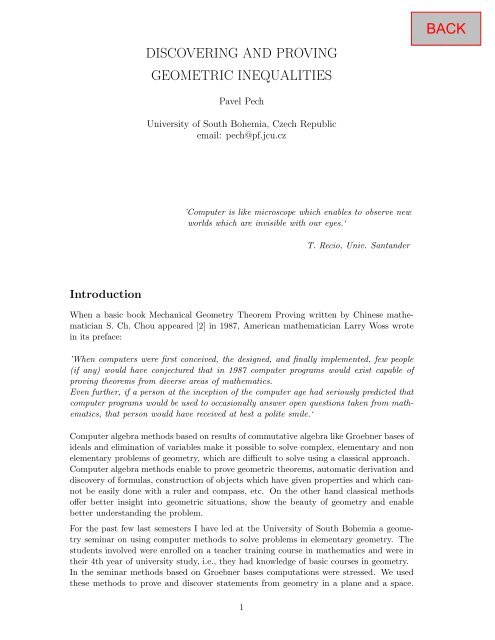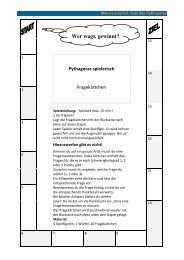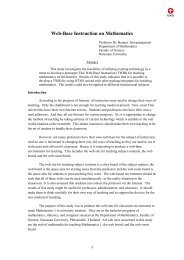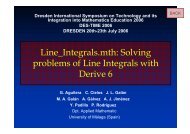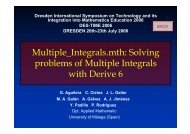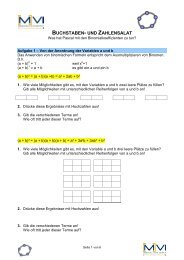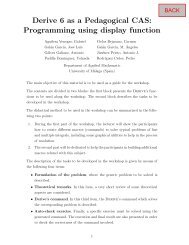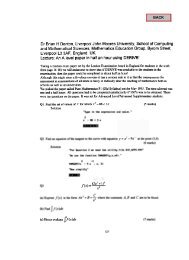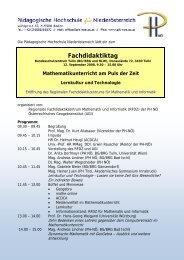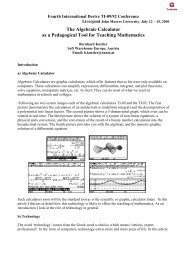Discovering and proving geometric inequalities by CAS (pdf)
Discovering and proving geometric inequalities by CAS (pdf)
Discovering and proving geometric inequalities by CAS (pdf)
Create successful ePaper yourself
Turn your PDF publications into a flip-book with our unique Google optimized e-Paper software.
Introduction<br />
DISCOVERING AND PROVING<br />
GEOMETRIC INEQUALITIES<br />
Pavel Pech<br />
University of South Bohemia, Czech Republic<br />
email: pech@pf.jcu.cz<br />
’Computer is like microscope which enables to observe new<br />
worlds which are invisible with our eyes.‘<br />
T. Recio, Univ. Sant<strong>and</strong>er<br />
When a basic book Mechanical Geometry Theorem Proving written <strong>by</strong> Chinese mathematician<br />
S. Ch. Chou appeared [2] in 1987, American mathematician Larry Woss wrote<br />
in its preface:<br />
’When computers were first conceived, the designed, <strong>and</strong> finally implemented, few people<br />
(if any) would have conjectured that in 1987 computer programs would exist capable of<br />
<strong>proving</strong> theorems from diverse areas of mathematics.<br />
Even further, if a person at the inception of the computer age had seriously predicted that<br />
computer programs would be used to occasionally answer open questions taken from mathematics,<br />
that person would have received at best a polite smile.‘<br />
Computer algebra methods based on results of commutative algebra like Groebner bases of<br />
ideals <strong>and</strong> elimination of variables make it possible to solve complex, elementary <strong>and</strong> non<br />
elementary problems of geometry, which are difficult to solve using a classical approach.<br />
Computer algebra methods enable to prove <strong>geometric</strong> theorems, automatic derivation <strong>and</strong><br />
discovery of formulas, construction of objects which have given properties <strong>and</strong> which cannot<br />
be easily done with a ruler <strong>and</strong> compass, etc. On the other h<strong>and</strong> classical methods<br />
offer better insight into <strong>geometric</strong> situations, show the beauty of geometry <strong>and</strong> enable<br />
better underst<strong>and</strong>ing the problem.<br />
For the past few last semesters I have led at the University of South Bohemia a geometry<br />
seminar on using computer methods to solve problems in elementary geometry. The<br />
students involved were enrolled on a teacher training course in mathematics <strong>and</strong> were in<br />
their 4th year of university study, i.e., they had knowledge of basic courses in geometry.<br />
In the seminar methods based on Groebner bases computations were stressed. We used<br />
these methods to prove <strong>and</strong> discover statements from geometry in a plane <strong>and</strong> a space.<br />
1
We also used this theory to carry out constructions of <strong>geometric</strong> objects which have given<br />
properties <strong>and</strong> which are not easy to construct <strong>by</strong> using ruler <strong>and</strong> compass.<br />
Automatic theorem <strong>proving</strong><br />
Automatic theorem <strong>proving</strong> is concerned with geometry statements of equality type, which<br />
are of the kind H ⇒ C, whereH is the set of hypotheses <strong>and</strong> C the conclusion.<br />
First we express the <strong>geometric</strong> problem in an algebraic form. Let K be a field of characteristic<br />
0, e.g. the field of rational numbers, <strong>and</strong> L be an algebraically closed which contains<br />
K, e.g. the field of complex numbers. The first stage of automatic theorem <strong>proving</strong> is<br />
characterized <strong>by</strong> establishing the set of hypotheses H whose algebraic form are polynomial<br />
equations<br />
h1(x1,x2,...,xn) =0, h2(x1,x2,...,xn) =0,...,hr(x1,x2,...,xn) =0<br />
<strong>and</strong> the conclusion C, which is expressed <strong>by</strong> the polynomial equation<br />
c(x1,x2,...,xn) =0,<br />
where h1,h2,...,hr,c∈ K[x1,x2,...,xn]. Thus the algebraic form of the statement is<br />
∀x ∈ L n , h1(x) =0, h2(x) =0, ..., hr(x) =0 ⇒ c(x) =0, (1)<br />
where we write x instead x1,x2,...,xn. The objective of the next step is a verification<br />
of (1). We are to decide whether the conclusion follows from the hypotheses or, which is<br />
the same, to decide whether the zero set of the conclusion C contains the zero set of the<br />
hypotheses H, i.e., Zero (H) ⊂ Zero (C).<br />
By the well-known Hilbert Nullstellensatz Theorem, the statement (1) is true iff 1 belongs<br />
Figure 1: H ⇒ C ⇔ Zero(H) ⊂ Zero(C)<br />
to the ideal (h1,h2,...,hr,ct − 1) of the hypotheses polynomials <strong>and</strong> negated conclusion.<br />
However for most geometry problems it suffices to show that c belongs to the ideal<br />
(h1,h2,...,hr). If yes we say that a statement (1) is generally true.<br />
See a nice book [3] for further study.<br />
Parallelogram law<br />
To demonstrate the base of automatic theorem <strong>proving</strong> we start with investigation of<br />
equalities between diagonals holding for various types of quadrilaterals. We will explore<br />
the equality between the sum of squares of sides <strong>and</strong> the sum of squares of diagonals of a<br />
parallelogram. This equality is known as the parallelogram law [6]:
Given a parallelogram with the lengths of sides a, b <strong>and</strong> diagonals e, f. Then<br />
Let us prove the relation (2) <strong>by</strong> computer.<br />
2(a 2 + b 2 )=e 2 + f 2 . (2)<br />
Denote the vertices of a parallelogram <strong>by</strong> letters A, B, C, D <strong>and</strong> its lengths of sides <strong>and</strong><br />
diagonals <strong>by</strong> a = |AB| = |CD|,b= |BC| = |DA|,e= |AC|,f = |BD|.<br />
Choose the coordinate system such that A =[0, 0],B =[a, 0],C =[x, y],D =[x − a, y].<br />
Then<br />
b = |BC|⇔h1 :(x − a) 2 + y 2 = b 2 ,<br />
e = |AC| ⇔h2 : x 2 + y 2 = e 2 ,<br />
f = |BD|⇔h3 :(x − 2a) 2 + y 2 = f 2 .<br />
The conclusion c is of the form<br />
c :2(a 2 + b 2 )=e 2 + f 2 .<br />
Figure 2: Parallelogram law: 2(a 2 + b 2 )=e 2 + f 2<br />
We have an ideal I =(h1,h2,h3) <strong>and</strong> we are to show that the conclusion polynomial<br />
c belongs to this ideal (or more exactly to the radical of I). We enter conditions into<br />
CoCoA 1 <strong>and</strong> get<br />
Use R::=Q[axybeft];<br />
I:=Ideal((x-a)^2+y^2-b^2,x^2+y^2-e^2,(x-2a)^2+y^2-f^2);<br />
NF(2(a^2+b^2)-(e^2+f^2),I);<br />
the result 0 means that the polynomial c can be expressed as the linear combination of<br />
hypotheses polynomials h1,h2,h3. Representation of c in terms of generators h1,h2,h3 can<br />
be shown <strong>by</strong> the comm<strong>and</strong> GenRepr <strong>and</strong> is as follows<br />
2(a 2 +b 2 )−(e 2 +f 2 )=−2·((x−a) 2 +y 2 −b 2 )+1·(x 2 +y 2 −e 2 )+1·((x−2a) 2 +y 2 −f 2 )).<br />
The parallelogram law is proved.<br />
A classical proof of the equality (2) is as follows:<br />
By the law of cosines in the triangle ABC it holds<br />
Analogously in the triangle ABD we have<br />
e 2 = a 2 + b 2 − 2ab cos ϕ.<br />
f 2 = a 2 + b 2 − 2ab cos(π − ϕ).<br />
1 Software CoCoA is distributed at cocoa@dima.unige.it
Figure 3: Parallelogram law: 2(a 2 + b 2 )=e 2 + f 2<br />
Summing up both equalities we get (2).<br />
We proved the statement above both in an automatic <strong>and</strong> classical way. Both methods<br />
have their strengths <strong>and</strong> weaknesses. The classical way required basic knowledge from<br />
elementary geometry (we used the law of cosines, etc.), gives us a good insight into the<br />
problem, but had one weakness - we had to have the key idea how to prove the statement.<br />
This is not always easy to find.<br />
On the other h<strong>and</strong> the automatic proof required basic knowledge from analytical geometry<br />
(”clever” introduction of coordinate system, expression of distances od vertices analytically,<br />
etc.), the computation was quite automatic. But this method was not so beautiful<br />
in <strong>geometric</strong> sense. This method can also lead to unexpected problems - e.g. to find non<br />
- degeneracy conditions.<br />
When students were asked which method they preferred <strong>and</strong> why, the answer was: ”the<br />
classical method because of a better insight into the problem.” They agreed with the conclusion<br />
that both methods should be combined <strong>and</strong> used in practice.<br />
Remark:<br />
The parallelogram law (2) had been already known in a little bit different form to ancient<br />
Greeks. It became familiar since the year 1935, when Jordan <strong>and</strong> von Neumann showed<br />
that Banach space in which (2) holds, is Hilbert space.<br />
The parallelogram law (2) can be generalized on a trapezoid:<br />
A quadrangle ABCD is a trapezoid with bases a, c, legs b, d <strong>and</strong> diagonals e, f if <strong>and</strong> only<br />
if<br />
b 2 + d 2 +2ac = e 2 + f 2 . (3)<br />
We will leave the proof to the reader.<br />
The relation<br />
2(a 2 + b 2 )=e 2 + f 2 .<br />
is a necessary condition for a quadrilateral ABCD to be a parallelogram. Is this condition<br />
also a sufficient condition?<br />
We will prove the following statement:<br />
A quadrilateral ABCD with sides a, b, c, d <strong>and</strong> diagonals e, f is given. Then ABCD is a<br />
parallelogram if <strong>and</strong> only if it holds<br />
a 2 + b 2 + c 2 + d 2 = e 2 + f 2 . (4)
Figure 4: In a trapezoid b 2 + d 2 +2ac = e 2 + f 2 holds<br />
One part of a statement has been already proved. Now assume that (4) is holding <strong>and</strong> we<br />
will explore all quadrilaterals which fulfil (4). We will show that ABCD is a parallelogram.<br />
Denote a = |AB|,b = |BC|,c = |CD|,d = |DA|,e = |AC|,f = |BD| <strong>and</strong> let A =<br />
[0, 0],B =[a, 0],C =[x, y],D =[u, v]. Then |BC| = b ⇔ h1 :(x − a) 2 + y 2 = b 2 ,<br />
Figure 5: a 2 + b 2 + c 2 + d 2 = e 2 + f 2 ⇔ ABCD is a parallelogram<br />
|CD| = c ⇔ h2 :(x − u) 2 +(y − v) 2 = c 2 ,<br />
|DA| = d ⇔ h3 : u 2 + v 2 = d 2 ,<br />
|AC| = e ⇔ h4 : x 2 + y 2 = e 2 ,<br />
|BD| = f ⇔ h5 :(u − a) 2 + v 2 = f 2 ,<br />
h6 : a 2 + b 2 + c 2 + d 2 = e 2 + f 2 .<br />
In the ideal I =(h1,h2,...,h6) we eliminate dependent variables b, c, d, e, f. We get<br />
Use R::=Q[xyuvabcdef];<br />
I:=Ideal((x-a)^2+y^2-b^2,(x-u)^2+(y-v)^2-c^2,u^2+v^2-d^2,x^2<br />
+y^2-e^2,(u-a)^2+v^2-f^2,a^2+b^2+c^2+d^2-e^2-f^2);<br />
Elim(b..f,I);<br />
the only condition x 2 + y 2 − 2xu + u 2 − 2yv + v 2 − 2xa +2ua + a 2 = 0 which is equivalent<br />
to<br />
(x − u − a) 2 +(y − v) 2 =0. (5)<br />
The condition (5) follows from given assumptions. It means that a quadrilateral is a<br />
parallelogram since for real numbers x, y, u, v, a the condition (5) implies x − u − a =0
<strong>and</strong> y − v =0, i.e., that A − D = B − C.<br />
Formal verification<br />
Use R::=Q[xyuvabcdef];<br />
I:=Ideal((x-a)^2+y^2-b^2,(x-u)^2+(y-v)^2-c^2,u^2+v^2-d^2,x^2<br />
+y^2-e^2,(u-a)^2+v^2-f^2,a^2+b^2+c^2+d^2-e^2-f^2);<br />
NF((x-u-a)^2+(y-v)^2,I);<br />
confirms that normal form equals 0 <strong>and</strong> a quadrilateral which fulfils a 2 +b 2 +c 2 +d 2 = e 2 +f 2<br />
is a parallelogram. The statement is true.<br />
Remark:<br />
If we would enter x − u − a =0<strong>and</strong>y − v =0, instead of the ”equivalent” condition<br />
(x − u − a) 2 +(y − v) 2 =0, which also characterizes a parallelogram, we have failed. We<br />
get<br />
Use R ::= Q[xyuvabcdefts];<br />
I:=Ideal((x-a)^2+y^2-b^2,(x-u)^2+(y-v)^2-c^2,u^2+v^2-d^2,<br />
x^2+y^2-e^2,(u-a)^2+v^2-f^2,a^2+b^2+c^2+d^2-e^2-f^2,(x-u-a)t-1);<br />
NF(1,I);<br />
the result 1.<br />
What is the difference between the conditions<br />
(x − u − a) 2 +(y − v) 2 =0 <strong>and</strong> x − u − a =0∧ y − v =0?<br />
’The only difference‘ consists in the fact that whereas in a real case both conditions are<br />
the same, in the case of complex numbers is (x − u − a) 2 +(y − v) 2 =(x − u − a +<br />
i(y − v))(x − u − a − i(y − v)), i.e., we get two conditions x − u − a + i(y − v) =0 ∨<br />
x − u − a − i(y − v) =0!<br />
This example should be instructive.<br />
We have always to consider such conditions which the system requires (<strong>and</strong> mostly yields).<br />
Any ”changes” of these conditions, despite they describe the reality properly, mostly lead<br />
to the failure.<br />
Solving <strong>inequalities</strong><br />
We will study some <strong>geometric</strong> <strong>inequalities</strong> discovered <strong>and</strong> proved <strong>by</strong> means of Buchberger’s<br />
algorithm for computing Groebner bases of ideals. However we should realize that we are<br />
working in an algebraic closed field, in our case in the field of complex numbers which, as<br />
known, can not be ordered. Hence we can not use the signs > or
Inequality between diagonals of a quadrilateral<br />
The following statement is a generalization of the parallelogram law on an arbitrary quadrilateral.<br />
It holds:<br />
Given a quadrilateral ABCD with lengths of sides a, b, c, d <strong>and</strong> diagonals e, f. Then<br />
a 2 + b 2 + c 2 + d 2 ≥ e 2 + f 2 . (6)<br />
The sign of equality in (6) is attained if <strong>and</strong> only if ABCD is a parallelogram.<br />
Let a = |AB|,b = |BC|,c = |CD|,d = |DA|,e = |AC|,f = |BD| <strong>and</strong> A =[0, 0],B =<br />
[a, 0],C =[x, y],D =[u, v]. Then<br />
Figure 6: In a quadrilateral ABCD the inequality a 2 + b 2 + c 2 + d 2 ≥ e 2 + f 2 holds<br />
b = |BC|⇔h1 :(x− a) 2 + y2 = b2 ,<br />
c = |CD|⇔h2 :(x− u) 2 +(y − v) 2 = c2 ,<br />
d = |DA| ⇔h3 : u2 + v2 = d2 ,<br />
e = |AC| ⇔h4 : x2 + y2 = e2 ,<br />
f = |BD|⇔h5 :(u− a) 2 + v2 = f 2 .<br />
To prove (6), we will try to express the difference (a2 + b2 + c2 + d2 ) − (e2 + f 2 )insuch<br />
a form from which non - negativity of (a2 + b2 + c2 + d2 ) − (e2 + f 2 ) would follow. We<br />
introduce a new variable k <strong>and</strong> put<br />
hence let<br />
h6 :(a 2 + b 2 + c 2 + d 2 ) − (e 2 + f 2 ) − k =0.<br />
(a 2 + b 2 + c 2 + d 2 ) − (e 2 + f 2 )=k, (7)<br />
In the ideal I =(h1,h2,...,h6) we eliminate dependent variables b, c, d, e, f to express k<br />
in terms of independent variables x, y, u, v, a.<br />
We get in CoCoA using the comm<strong>and</strong> Elim<br />
Use R::=Q[xyuvabcdefk];<br />
J:=Ideal((x-a)^2+y^2-b^2,(x-u)^2+(y-v)^2-c^2,u^2+v^2-d^2,<br />
x^2+y^2-e^2,(u-a)^2+v^2-f^2,a^2+b^2+c^2+d^2-e^2-f^2-k);<br />
Elim(b..f,J);<br />
or in Derive using the comm<strong>and</strong> GROEBNER BASIS
2 2 2 2 2 2 2<br />
GROEBNER_BASIS((x-a) + y - b ,(x-u) + (y-v) - c , u +<br />
2 2 2 2 2 2 2 2 2 2 2 2 2<br />
v - d , x + y - e ,(u-a) + v - f , a + b + c + d - e -<br />
2<br />
f - k, [b, c, d, e, f, a, x, y, u, v, k])<br />
the polynomial<br />
x 2 + y 2 − 2xu + u 2 − 2yv + v 2 − 2xa +2ua + a 2 − k.<br />
This polynomial can be expressed in the form of the sum of squares<br />
k =(x − u − a) 2 +(y − v) 2 . (8)<br />
Substitution of k from (8) into (7) gives the following identity<br />
a 2 + b 2 + c 2 + d 2 − e 2 − f 2 =(x − u − a) 2 +(y − v) 2 , (9)<br />
which implies the inequality (6). The equality in (6) is attained if <strong>and</strong> only if ABCD is a<br />
parallelogram as we could see from the parallelogram law.<br />
Instead of (6) we can write (9) which describes the situation better including the case of<br />
equality. By (9) we rediscovered the theorem which is ascribed to L. Euler [8]:<br />
Given a skew quadrilateral ABCD. DenoteP, Q the midpoints of diagonals AC <strong>and</strong> BD<br />
respectively. Then<br />
|AB| 2 + |BC| 2 + |CD| 2 + |DA| 2 −|AC| 2 −|BD| 2 =4|PQ| 2 . (10)<br />
A close inspection shows that the relation (10) is equal to (9).<br />
Figure 7: In a skew quadrilateral |AB| 2 +|BC| 2 +|CD| 2 +|DA| 2 = |AC| 2 +|BD| 2 +4|PQ| 2<br />
holds<br />
General case<br />
The inequality (6) is a special case of the following theorem which was published in 1980<br />
<strong>by</strong> L. Gerber [6]:<br />
Let Π=P0,P1,...,Pn−1 be a closed skew n-gon in the Euclidean space E N . Then<br />
n−1 <br />
k=0<br />
|PkPk+2| 2 n−1<br />
2 π<br />
≤ 4cos<br />
n<br />
k=0<br />
<br />
|PkPk+1| 2 , (11)
with the equality if <strong>and</strong> only if Π is a planar affine-regular n-gon.<br />
For n = 4 we get the relation (6) since an affine image of a square is a parallelogram.<br />
Another generalization of the inequality (11) was published in 1990 <strong>by</strong> P. Pech, see [11].<br />
It is as follows:<br />
Let Π=P0,P1,...,Pn−1 be a closed skew n-gon in the Euclidean space E N <strong>and</strong> let Pn+j =<br />
Pj, for j =0, 1,... Then for all p =0, 1,...,n− 1<br />
<br />
n−1<br />
2 π<br />
sin |PkPk+p|<br />
n<br />
k=0<br />
2 ≤ sin 2 (p π<br />
n )<br />
n−1<br />
k=0<br />
with the equality if <strong>and</strong> only if Π is a planar affine-regular n-gon.<br />
For p = 2 we get from (12) the inequality (11).<br />
Euler’s inequality<br />
<br />
|PkPk+1| 2 , (12)<br />
In 1765 L. Euler [5] published the relation (13) which expresses the distance d of the<br />
incenter <strong>and</strong> circumcenter of an arbitrary triangle<br />
where r is the circumradius <strong>and</strong> p is the inradius.<br />
d = r(r − 2p) , (13)<br />
In [10] it is given that H. Wieleitner [14] mentions, that the relation (13) was published<br />
Figure 8: Euler’s relation: d = r(r − 2p)<br />
even earlier <strong>by</strong> W. Chapple from Engl<strong>and</strong> in 1746.<br />
The following inequality, which is a consequence of (13), is<br />
r ≥ 2p , (14)<br />
called Euler’s inequality [4]. It is obvious that the equality in (14) is attained iff a triangle<br />
is equilateral, because only in this case the circumcenter <strong>and</strong> incenter coincide <strong>and</strong> d =0<br />
in (13).<br />
We will prove the Euler’s inequality (14) <strong>by</strong> computer. We will proceed in a similar way<br />
as W. Koepf [7] without introducing a coordinate system.<br />
Let ABC be an arbitrary triangle with the lengths of sides a, b, c. Denote <strong>by</strong> r <strong>and</strong> p its
circumradius <strong>and</strong> inradius respectively <strong>and</strong> let f be the area of ABC. For the area f of a<br />
triangle ABC we have the following familiar relations:<br />
h1 : f − p(a + b + c)/2 =0,<br />
h2 : f − abc/(4r) =0,<br />
h3 :16f 2 − (a + b + c)(−a + b + c)(a − b + c)(a + b − c) =0.<br />
Suppose that a, b, c, p, r, f are positive real numbers. The main idea of the method is as<br />
follows. We will try to express r − 2p in such a form from which it would be clear that<br />
r − 2p is greater than or equals zero. That is why we introduce a slack variable k such<br />
that r − 2p = k, i.e.,<br />
h4 : r − 2p − k.<br />
In the ideal I =(h1,h2,h3,h4) we will eliminate p <strong>and</strong> r to obtain polynomials in variables<br />
a, b, c, f, k. We enter in CoCoA using the comm<strong>and</strong> Elim<br />
Use R::=Q[abcprfk];<br />
I:=Ideal(2f-p(a+b+c),4fr-abc,16f^2-(a+b+c)(-a+b+c)(a-b+c)(a+b-c),<br />
r-2p-k);<br />
Elim(p..r,I);<br />
<strong>and</strong> get a few polynomials from which the following one, after dividing it with a non zero<br />
factor f, leads to the equation of the form<br />
4fk = a 3 − a 2 b − ab 2 + b 3 − a 2 c +3abc − b 2 c − ac 2 − bc 2 + c 3 . (15)<br />
From (15) we see that the expression k = r − 2p is non-negative iff the polynomial on the<br />
right in (15) is non-negative. It is easy to show that the equality<br />
a 3 − a 2 b − ab 2 + b 3 − a 2 c +3abc − b 2 c − ac 2 − bc 2 + c 3 =<br />
=1/2[(a + b − c)(a − b) 2 +(b + c − a)(b − c) 2 +(c + a − b)(c − a) 2 ] (16)<br />
holds, cf. [7]. The expression on the right h<strong>and</strong> side in (16) is non-negative. Namely it is<br />
the sum of non negative expressions which consist of squares (a − b) 2 , (b − c) 2 , (c − a) 2 <strong>and</strong><br />
expressions a + b − c, b + c − a, c + a − b which are positive due to the triangle inequality.<br />
The equality in (14) occurs if <strong>and</strong> only if a = b = c in (16) on the right, i.e., iff a triangle<br />
ABC is equilateral.<br />
Remark:<br />
In order to prove (14) we could also prove the equality (13) from which the inequality (14)<br />
follows, see [13].<br />
The following classical proof is ascribed to Hungarian mathematician I. Ádám [10]. His<br />
proof is very smart:<br />
The midpoints A1,B1,C1 of sides of a triangle ABC form a triangle whose circumcircle<br />
has the radius r/2. Construct a triangle A ′ B ′ C ′ whose sides are parallel to the sides of a<br />
triangle ABC so that the circumcircle of a triangle A1,B1,C1 is the incircle of A ′ B ′ C ′ .<br />
Since △ABC ⊆△A ′ B ′ C ′ then for inradii p, r/2 of both triangles the relation p ≤ r/2<br />
holds. The classical proof is now complete.<br />
The proof just given can be easily applied to a tetrahedron <strong>and</strong> in general to an arbitrary<br />
simplex in n-dimensional Euclidean space E n . For the radii p <strong>and</strong> r of spheres which are<br />
inscribed <strong>and</strong> circumscribed to a tetrahedron analogous relation to (14)<br />
r ≥ 3p , (17)<br />
holds. The midpoints of sides are then replaced <strong>by</strong> the centroids of faces of a tetrahedron.
References<br />
Figure 9: A classical proof of the Euler’s inequality<br />
[1] W. Blaschke: Kreis und Kugel. Walter de Gruyter & Co, Berlin 1956.<br />
[2] S.C. Chou: Mechanical Geometry Theorem Proving. D. Reidel Publishing Company,<br />
Dordrecht 1987.<br />
[3] D. Cox, J. Little, D. O’Shea: Ideals, Varieties, <strong>and</strong> Algorithms. Second Edition,<br />
Springer 1997.<br />
[4] O. Bottema et al: Geometric <strong>inequalities</strong>. Groningen 1969.<br />
[5] L. Euleri: Novi commentarii academicae scientiarum Petropolitanae 11 (1765),<br />
1767, 103-123.<br />
[6] L. Gerber: Napoleon’s theorem <strong>and</strong> the parallelogram inequality for affine-regular<br />
polygons. Amer. Math. Monthly 87 (1980), 644-648.<br />
[7] W. Koepf: Gröbner Bases <strong>and</strong> Triangles. International Journal of Computer Algebra<br />
in Mathematics Education 4 (1997), 371-386.<br />
[8] A.G. Konforovič: V´yznamné matematické úlohy. SPN, Praha 1989.<br />
[9] D.S. Mitrinovič, J.E. Pečarič, V. Volenec: Recent Advances in Geometric<br />
Inequalities. Kluwer Academic Publishers, Dordrecht/Boston/London, 1989.<br />
[10] Z. Nádeník: Náměty k stˇredoˇskolské geometrii. Pokroky matematiky, fyziky a astronomie<br />
19, No. 6, (1974).<br />
[11] P. Pech: Inequality between sides <strong>and</strong> diagonals of a space n-gon <strong>and</strong> its integral<br />
analog. Čas. pro pěst. mat. 115 (1990), 343-350.<br />
[12] P. Pech: Klasické versus počítačové metody pˇri ˇreˇsení problém˚u v geometrii .<br />
Jihočeská univerzita v Česk´ych Budějovicích, 2005.<br />
[13] D. Wang: Elimination Practice. Software Tools <strong>and</strong> Applications. Imperial College<br />
Press, London, 2004.<br />
[14] H. Wieleitner: Geschichte der Mathematik, II. Teil.1911-1921, Russian translation<br />
1958, 2. edition 1966.


